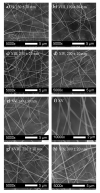Electrospinning of PCL-Based Blends: Processing Optimization for Their Scalable Production
- PMID: 32882860
- PMCID: PMC7504022
- DOI: 10.3390/ma13173853
Electrospinning of PCL-Based Blends: Processing Optimization for Their Scalable Production
Abstract
In this work poly(ε-caprolactone) (PCL) based electrospun mats were prepared by blending PCL with microcrystalline cellulose (MCC) and poly(3-hydroxybutyrate) (PHB). The electrospinning processing parameters were firstly optimized with the aim to obtain scalable PCL-based electrospun mats to be used in the industrial sector. Neat PCL as well as PCL-MCC and PCL-PHB based mats in different proportions (99:1; 95:5; 90:10) were prepared. A complete morphological, thermal and mechanical characterization of the developed materials was carried out. Scanning electron microscopy (SEM) observations showed that the addition of PHB to the PCL matrix considerably reduced the formation of beads. Both the addition of MCC and PHB reduced the thermal stability of PCL, but obtained materials with enough thermal stability for the intended use. The electrospun PCL fibers show greatly reduced flexibility with respect to the PCL bulk material, however when PCL is blended with PHB their stretchability is increased, changing their elongation at break from 35% to 70% when 10 wt% of PHB is blended with PCL. However, the mechanical response of the different blends increases with respect to the neat electrospun PCL, offering the possibility to modulate their properties according to the required industrial applications.
Keywords: blends; electrospinning; microcrystalline cellulose; poly(3-hydroxybutyrate); poly(ε-caprolactone); stretchability.
Conflict of interest statement
The authors declare no conflict of interest.
Figures









References
-
- Reneker D.H., Yarin A.L. Electrospinning jets and polymer nanofibers. Polymer. 2008;49:2387–2425. doi: 10.1016/j.polymer.2008.02.002. - DOI
-
- Cherpinski A., Torres-Giner S., Vartiainen J., Peresin M.S., Lahtinen P., Lagaron J.M. Improving the water resistance of nanocellulose-based films with polyhydroxyalkanoates processed by the electrospinning coating technique. Cellulose. 2018;25:1291–1307. doi: 10.1007/s10570-018-1648-z. - DOI
-
- Peponi L., Mújica-García A., Kenny J.M. Hyperbranched Polymers: Macromolecules in between Deterministic Linear Chains and Dendrimer Structures. Royal Society of Chemistry; London, UK: 2015. Electrospinning of PLA; pp. 171–194.
-
- Lima L.L., Bierhalz A.C.K., Moraes Â.M. Influence of the chemical composition and structure design of electrospun matrices on the release kinetics of Aloe vera extract rich in aloin. Polym. Degrad. Stab. 2020;179:109233. doi: 10.1016/j.polymdegradstab.2020.109233. - DOI
-
- Mujica-Garcia A., Navarro-Baena I., Kenny J.M., Peponi L. Influence of the Processing Parameters on the Electrospinning of Biopolymeric Fibers. J. Renew. Mater. 2014;2:23–34. doi: 10.7569/JRM.2013.634130. - DOI
Grants and funding
LinkOut - more resources
Full Text Sources

